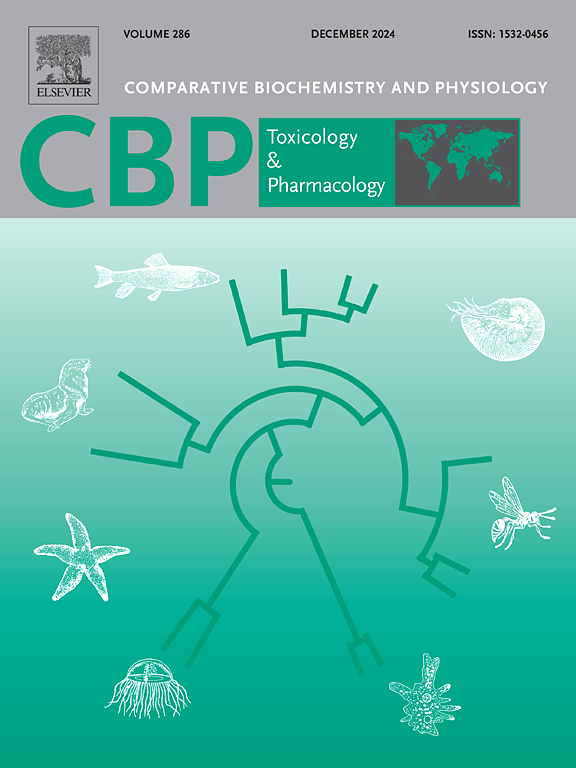Dinotefuran exposure induces immunotoxicity in zebrafish embryos
IF 3.9
3区 环境科学与生态学
Q2 BIOCHEMISTRY & MOLECULAR BIOLOGY
Comparative Biochemistry and Physiology C-toxicology & Pharmacology
Pub Date : 2025-04-11
DOI:10.1016/j.cbpc.2025.110206
引用次数: 0
Abstract
As a typical neonicotinoid insecticide, dinotefuran (DIN) has immunotoxicity, but its immunotoxicity effects on aquatic organisms and its molecular mechanisms are not known. In this study, zebrafish embryos were used as model to reveal its immunotoxicity and its mechanism from the perspective of inflammatory response. Zebrafish larvae were exposed to DIN at environmentally relevant concentrations (0, 2, 200, and 2000 mg/L) for 120 h, followed by comprehensive analyses of immune cell populations, immune marker activities, oxidative stress levels, and gene expression profiles. The results showed that the number of neutrophils and macrophages, two types of innate immune cells, was significantly reduced, and the activities of the immune markers, lysozyme (LYS), immunoglobulin M (IgM), and complement protein C3, were significantly inhibited. The level of oxidative stress in zebrafish larvae was significantly elevated and antioxidant enzyme activities were markedly inhibited in a dose-dependent manner after exposure to DIN. In this case, pro-inflammatory cytokines such as TNF-α, IL-6 and IL-1β were also abnormally expressed, and the expression levels of the genes related to the NF-κB pathway and the JNK-STAT pathway, tlr4a, myd88, nf-κb p65, jak1, jak2, and stat3, were elevated. The expression levels of genes related to the antioxidant signaling pathway Nrf2-keap1 signaling pathway were suppressed. Taken together, our results suggest that DIN exposure causes damage to the immune system of zebrafish embryos-larvae, generating oxidative stress and inflammatory responses that lead to immunotoxicity.

接触克百威可诱导斑马鱼胚胎产生免疫毒性
作为一种典型的新烟碱类杀虫剂,呋喃(dinotefuran, DIN)具有免疫毒性,但其对水生生物的免疫毒性作用及其分子机制尚不清楚。本研究以斑马鱼胚胎为模型,从炎症反应的角度揭示其免疫毒性及其机制。将斑马鱼幼虫暴露于环境相关浓度(0、2、200和2000 mg/L)的DIN中120小时,然后对免疫细胞群、免疫标记物活性、氧化应激水平和基因表达谱进行综合分析。结果表明,小鼠先天免疫细胞中性粒细胞和巨噬细胞数量显著减少,免疫标志物溶菌酶(LYS)、免疫球蛋白M (IgM)和补体蛋白C3活性显著抑制。暴露于DIN后,斑马鱼幼鱼体内氧化应激水平显著升高,抗氧化酶活性明显受到抑制,且呈剂量依赖性。TNF-α、IL-6、IL-1β等促炎因子也异常表达,NF-κB通路和JNK-STAT通路相关基因tlr4a、myd88、NF-κB p65、jak1、jak2、stat3表达水平升高。抗氧化信号通路相关基因Nrf2-keap1的表达水平受到抑制。综上所述,我们的研究结果表明,DIN暴露会损害斑马鱼胚胎-幼虫的免疫系统,产生氧化应激和炎症反应,从而导致免疫毒性。
本文章由计算机程序翻译,如有差异,请以英文原文为准。
求助全文
约1分钟内获得全文
求助全文
来源期刊
CiteScore
7.50
自引率
5.10%
发文量
206
审稿时长
30 days
期刊介绍:
Part C: Toxicology and Pharmacology. This journal is concerned with chemical and drug action at different levels of organization, biotransformation of xenobiotics, mechanisms of toxicity, including reactive oxygen species and carcinogenesis, endocrine disruptors, natural products chemistry, and signal transduction with a molecular approach to these fields.

 求助内容:
求助内容: 应助结果提醒方式:
应助结果提醒方式:


